2003 FORD MUSTANG light
[x] Cancel search: lightPage 110 of 256
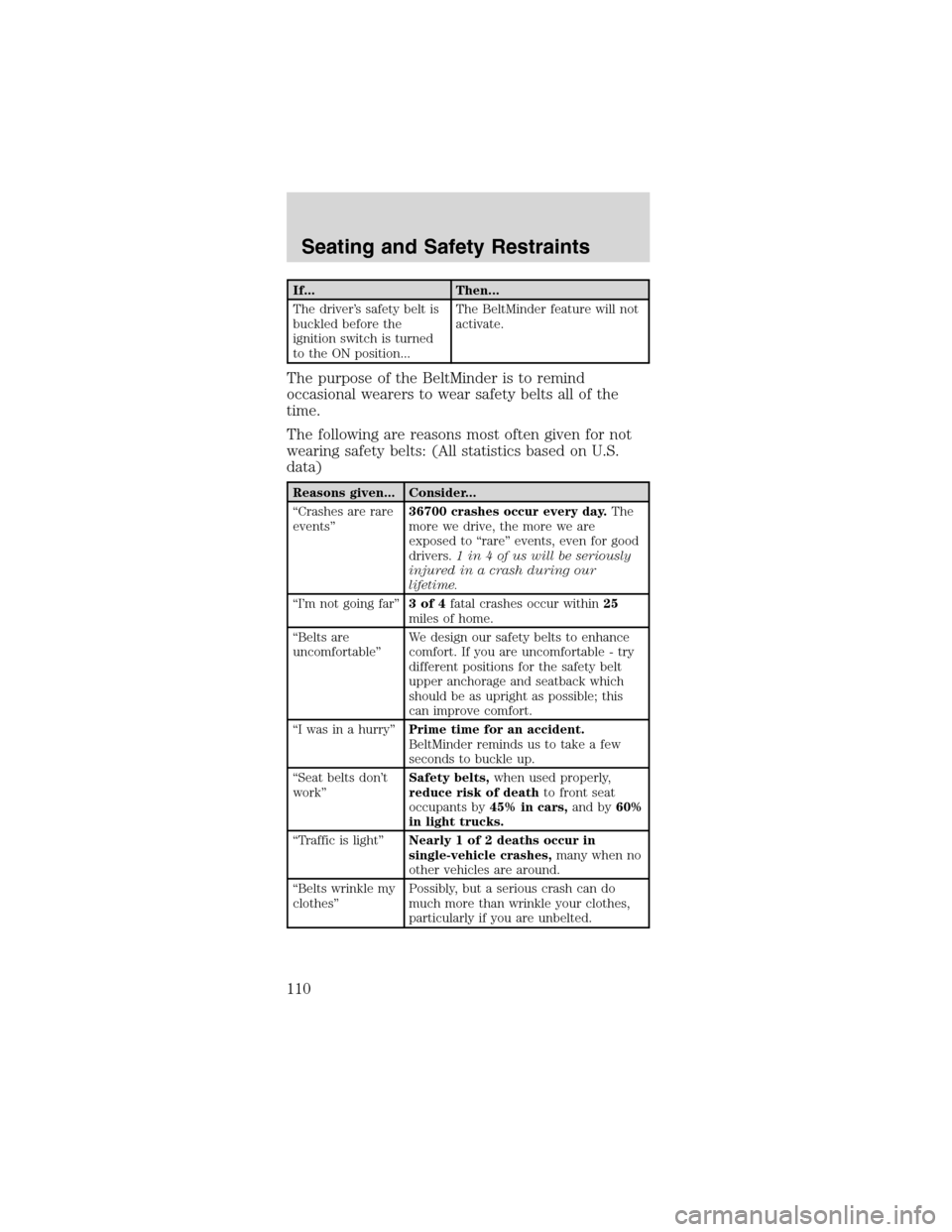
If... Then...
The driver’s safety belt is
buckled before the
ignition switch is turned
to the ON position...The BeltMinder feature will not
activate.
The purpose of the BeltMinder is to remind
occasional wearers to wear safety belts all of the
time.
The following are reasons most often given for not
wearing safety belts: (All statistics based on U.S.
data)
Reasons given... Consider...
“Crashes are rare
events”36700 crashes occur every day.The
more we drive, the more we are
exposed to“rare”events, even for good
drivers.1 in 4 of us will be seriously
injured in a crash during our
lifetime.
“I’m not going far”3of4fatal crashes occur within25
miles of home.
“Belts are
uncomfortable”We design our safety belts to enhance
comfort. If you are uncomfortable - try
different positions for the safety belt
upper anchorage and seatback which
should be as upright as possible; this
can improve comfort.
“I was in a hurry”Prime time for an accident.
BeltMinder reminds us to take a few
seconds to buckle up.
“Seat belts don’t
work”Safety belts,when used properly,
reduce risk of deathto front seat
occupants by45% in cars,and by60%
in light trucks.
“Traffic is light”Nearly 1 of 2 deaths occur in
single-vehicle crashes,many when no
other vehicles are around.
“Belts wrinkle my
clothes”Possibly, but a serious crash can do
much more than wrinkle your clothes,
particularly if you are unbelted.
Seating and Safety Restraints
110
Page 112 of 256

•The driver’s safety belt is unbuckled.
•The parklamps/headlamps are in OFF position (If
vehicle is equipped with Autolamps, this will not
affect the procedure).
To reduce the risk of injury, do not
deactivate/activate the Belt Minder feature
while driving the vehicle.
BeltMinder activation and deactivation
procedure
1. Turn the ignition switch to the RUN (or ON)
position. (DO NOT START THE ENGINE.)
2. Wait until the safety belt warning light turns off.
(Approximately 1–2 minutes.)
•Steps 3–5 must be completed within 60 seconds
or the procedure will have to be repeated.
3. Buckle then unbuckle the safety belt three times,
ending with the safety belt unbuckled. This can be
done before or during BeltMinder warning activation.
4. Turn on the parklamps/headlamps, turn off the
parklamps/headlamps.
5. Buckle then unbuckle the safety belt three times,
ending with the safety belt unbuckled.
•After step 5 the safety belt warning light will be
turned on for three seconds.
6. Within seven seconds of the safety belt warning
light turning off, buckle then unbuckle the safety
belt.
•This will disable BeltMinder if it is currently
enabled, or enable BeltMinder if it is currently
disabled.
7. Confirmation of disabling BeltMinder is provided
by the safety belt warning light flashing four times
per second for three seconds.
8. Confirmation of enabling BeltMinder is provided
by:
•The safety belt warning light flashing four times
per second for three seconds.
Seating and Safety Restraints
112
Page 113 of 256
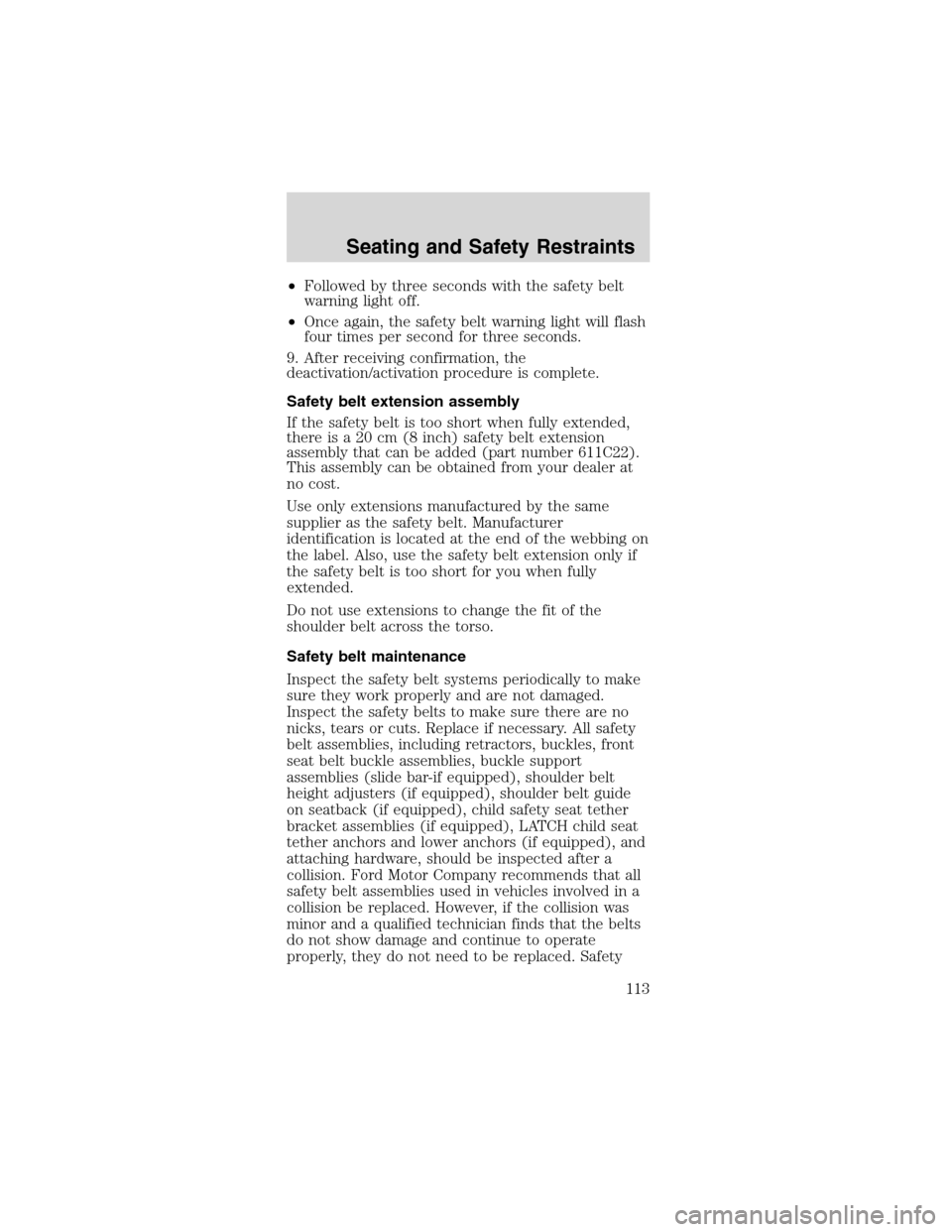
•Followed by three seconds with the safety belt
warning light off.
•Once again, the safety belt warning light will flash
four times per second for three seconds.
9. After receiving confirmation, the
deactivation/activation procedure is complete.
Safety belt extension assembly
If the safety belt is too short when fully extended,
there is a 20 cm (8 inch) safety belt extension
assembly that can be added (part number 611C22).
This assembly can be obtained from your dealer at
no cost.
Use only extensions manufactured by the same
supplier as the safety belt. Manufacturer
identification is located at the end of the webbing on
the label. Also, use the safety belt extension only if
the safety belt is too short for you when fully
extended.
Do not use extensions to change the fit of the
shoulder belt across the torso.
Safety belt maintenance
Inspect the safety belt systems periodically to make
sure they work properly and are not damaged.
Inspect the safety belts to make sure there are no
nicks, tears or cuts. Replace if necessary. All safety
belt assemblies, including retractors, buckles, front
seat belt buckle assemblies, buckle support
assemblies (slide bar-if equipped), shoulder belt
height adjusters (if equipped), shoulder belt guide
on seatback (if equipped), child safety seat tether
bracket assemblies (if equipped), LATCH child seat
tether anchors and lower anchors (if equipped), and
attaching hardware, should be inspected after a
collision. Ford Motor Company recommends that all
safety belt assemblies used in vehicles involved in a
collision be replaced. However, if the collision was
minor and a qualified technician finds that the belts
do not show damage and continue to operate
properly, they do not need to be replaced. Safety
Seating and Safety Restraints
113
Page 116 of 256
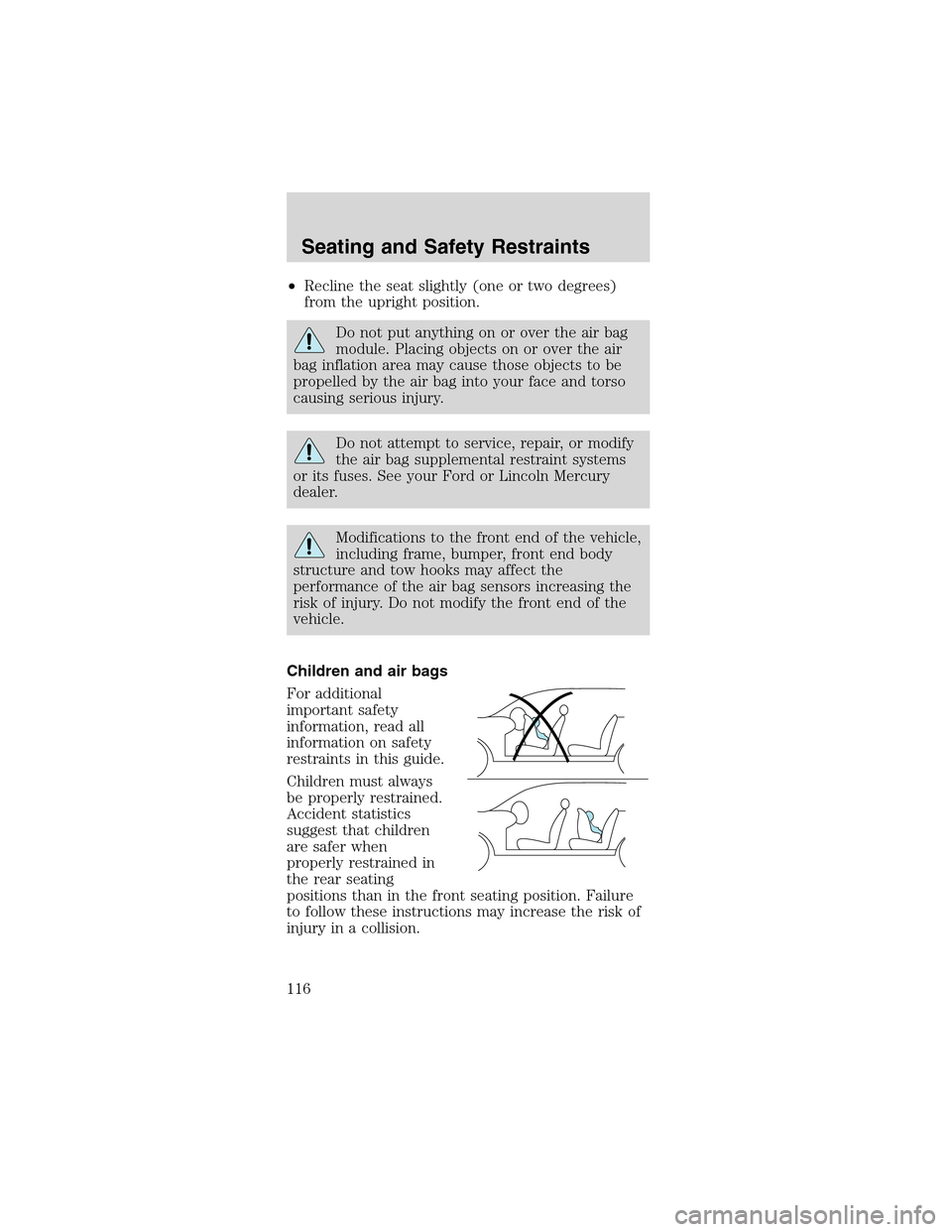
•Recline the seat slightly (one or two degrees)
from the upright position.
Do not put anything on or over the air bag
module. Placing objects on or over the air
bag inflation area may cause those objects to be
propelled by the air bag into your face and torso
causing serious injury.
Do not attempt to service, repair, or modify
the air bag supplemental restraint systems
or its fuses. See your Ford or Lincoln Mercury
dealer.
Modifications to the front end of the vehicle,
including frame, bumper, front end body
structure and tow hooks may affect the
performance of the air bag sensors increasing the
risk of injury. Do not modify the front end of the
vehicle.
Children and air bags
For additional
important safety
information, read all
information on safety
restraints in this guide.
Children must always
be properly restrained.
Accident statistics
suggest that children
are safer when
properly restrained in
the rear seating
positions than in the front seating position. Failure
to follow these instructions may increase the risk of
injury in a collision.
Seating and Safety Restraints
116
Page 118 of 256

amounts of sodium hydroxide may be present which
may irritate the skin and eyes, but none of the
residue is toxic.
While the system is designed to help reduce serious
injuries, contact with a deploying air bag may also
cause abrasions, swelling or temporary hearing loss.
Because air bags must inflate rapidly and with
considerable force, there is the risk of death or
serious injuries such as fractures, facial and eye
injuries or internal injuries, particularly to occupants
who are not properly restrained or are otherwise out
of position at the time of air bag deployment. Thus,
it is extremely important that occupants be properly
restrained as far away from the air bag module as
possible while maintaining vehicle control.
The SRS consists of:
•driver and passenger air bag modules (which
include the inflators and air bags)
•one or more impact and safing sensors
•a readiness light and tone
•a diagnostic module
•and the electrical wiring which connects the
components
The diagnostic module monitors its own internal
circuits and the supplemental air bag electrical
system warning (including the impact sensors), the
system wiring, the air bag system readiness light, the
air bag back up power and the air bag ignitors.
Several air bag system components get hot
after inflation. Do not touch them after
inflation.
If the air bag has deployed,the air bag will
not function again and must be replaced
immediately.If the air bag is not replaced, the
unrepaired area will increase the risk of injury in a
collision.
Seating and Safety Restraints
118
Page 119 of 256
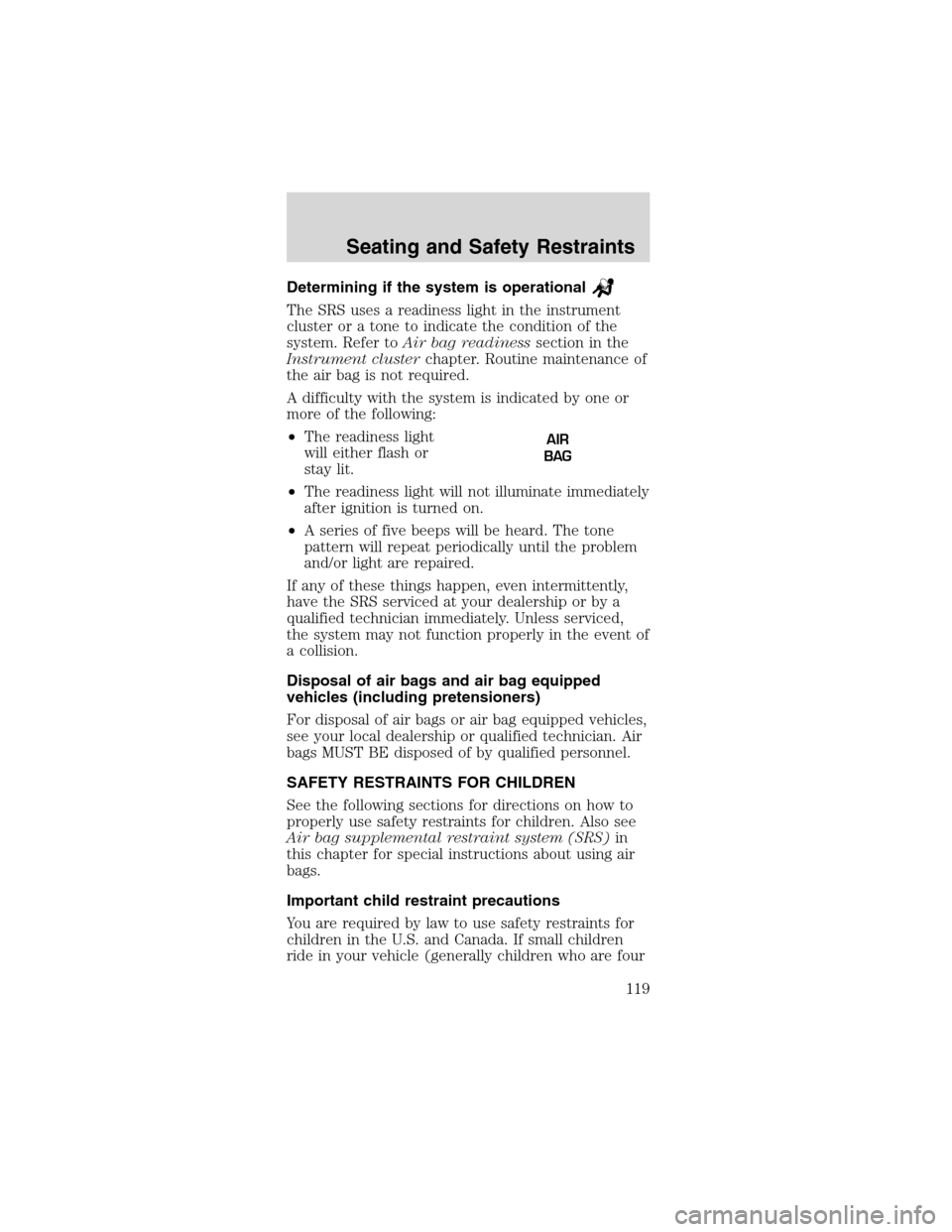
Determining if the system is operational
The SRS uses a readiness light in the instrument
cluster or a tone to indicate the condition of the
system. Refer toAir bag readinesssection in the
Instrument clusterchapter. Routine maintenance of
the air bag is not required.
A difficulty with the system is indicated by one or
more of the following:
•The readiness light
will either flash or
stay lit.
•The readiness light will not illuminate immediately
after ignition is turned on.
•A series of five beeps will be heard. The tone
pattern will repeat periodically until the problem
and/or light are repaired.
If any of these things happen, even intermittently,
have the SRS serviced at your dealership or by a
qualified technician immediately. Unless serviced,
the system may not function properly in the event of
a collision.
Disposal of air bags and air bag equipped
vehicles (including pretensioners)
For disposal of air bags or air bag equipped vehicles,
see your local dealership or qualified technician. Air
bags MUST BE disposed of by qualified personnel.
SAFETY RESTRAINTS FOR CHILDREN
See the following sections for directions on how to
properly use safety restraints for children. Also see
Air bag supplemental restraint system (SRS)in
this chapter for special instructions about using air
bags.
Important child restraint precautions
You are required by law to use safety restraints for
children in the U.S. and Canada. If small children
ride in your vehicle (generally children who are four
AIR
BAG
Seating and Safety Restraints
119
Page 133 of 256
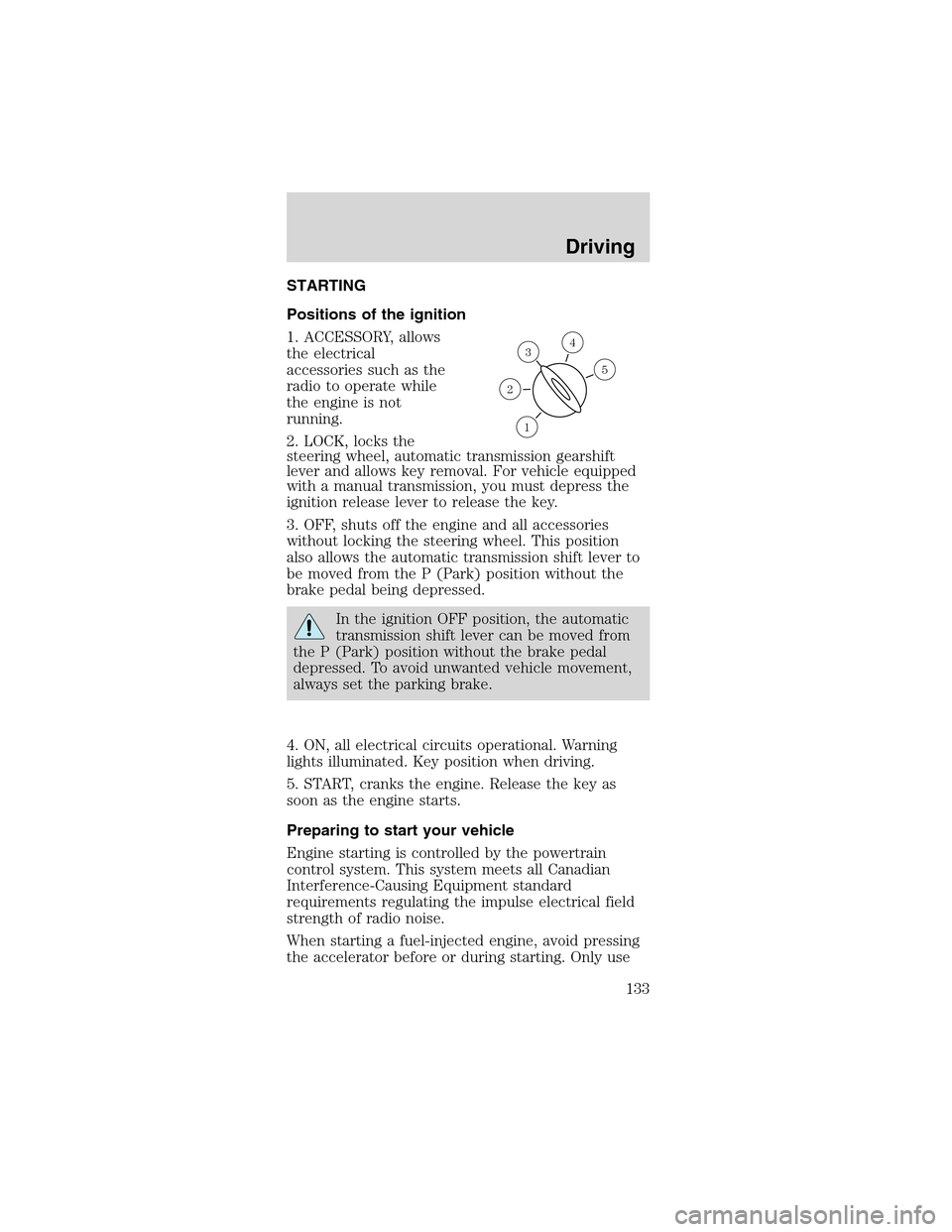
STARTING
Positions of the ignition
1. ACCESSORY, allows
the electrical
accessories such as the
radio to operate while
the engine is not
running.
2. LOCK, locks the
steering wheel, automatic transmission gearshift
lever and allows key removal. For vehicle equipped
with a manual transmission, you must depress the
ignition release lever to release the key.
3. OFF, shuts off the engine and all accessories
without locking the steering wheel. This position
also allows the automatic transmission shift lever to
be moved from the P (Park) position without the
brake pedal being depressed.
In the ignition OFF position, the automatic
transmission shift lever can be moved from
the P (Park) position without the brake pedal
depressed. To avoid unwanted vehicle movement,
always set the parking brake.
4. ON, all electrical circuits operational. Warning
lights illuminated. Key position when driving.
5. START, cranks the engine. Release the key as
soon as the engine starts.
Preparing to start your vehicle
Engine starting is controlled by the powertrain
control system. This system meets all Canadian
Interference-Causing Equipment standard
requirements regulating the impulse electrical field
strength of radio noise.
When starting a fuel-injected engine, avoid pressing
the accelerator before or during starting. Only use
3
1
2
5
4
Driving
133
Page 136 of 256
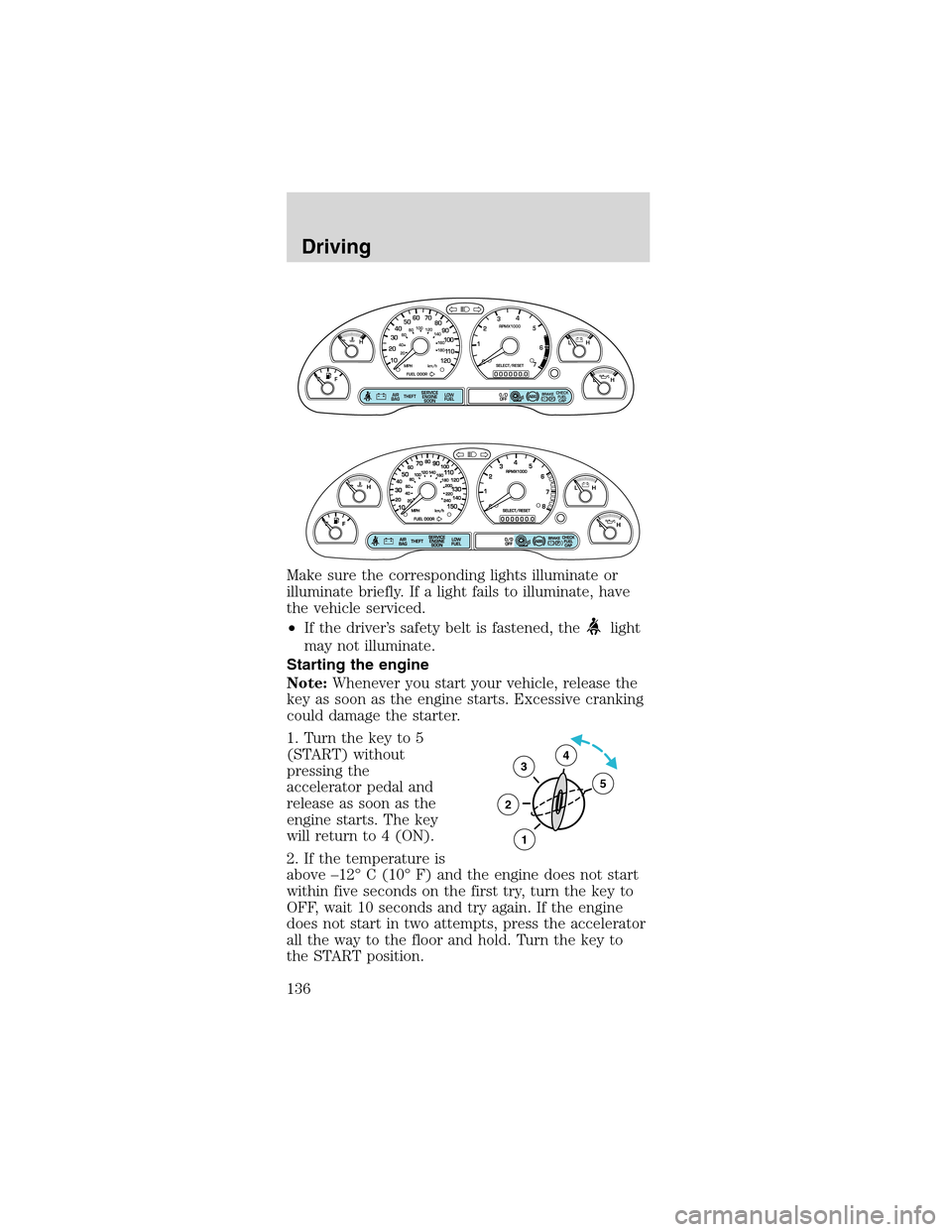
Makesurethecorrespondinglights illuminate or
illuminate briefly. If a light fails to illuminate, have
the vehicle serviced.
•If the driver’s safety belt is fastened, the
light
may not illuminate.
Starting the engine
Note:Whenever you start your vehicle, release the
key as soon as the engine starts. Excessive cranking
could damage the starter.
1. Turn the key to 5
(START) without
pressing the
accelerator pedal and
release as soon as the
engine starts. The key
will return to 4 (ON).
2. If the temperature is
above–12°C (10°F) and the engine does not start
within five seconds on the first try, turn the key to
OFF, wait 10 seconds and try again. If the engine
does not start in two attempts, press the accelerator
all the way to the floor and hold. Turn the key to
the START position.
P! BRAKE
L
0
00000 00
C
E
FH
LH
10 203020 406080100
120
140
160
180
405060 70
80
90
100
11 0
1204
5
6
7 3
2
1
H
THEFT
RPMX1000
FUEL DOORSELECT/RESET
LOW
FUELO/D
OFF AIR
BAGSERVICE
ENGINE
SOON
MPH km/h
ABS
.
CHECK
FUEL
CAP
3
2
1
5
4
Driving
136